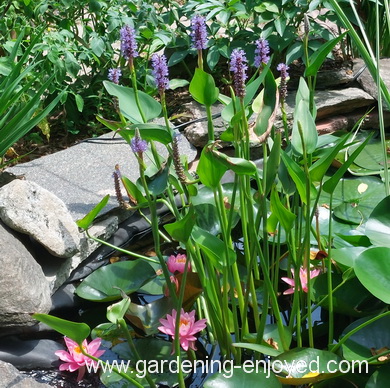
Caught these two beauties blooming with each other in the middle pond and thought they made a wonderful combination. I’d like you to believe that I actually planned the combination but we know that I’m really not that organized. The pink Waterlily is something that I must have purchased at some point. The tall blue Pickerel weed, Pontederia cordata, I remember digging out of the York river on a canoe trip several years ago. They are both great pond plants but a bit aggressive and should maybe be in containers in the pond. My middle pond is overflowing with vegetation because I don’t use any containers there. It makes for wonderful growth and flowering but it also tends to require cleanout much more often as those plants produce huge roots that tend to occupy the whole pond in 3 or 4 years. It seems that nothing worth having comes without the attendant effort.
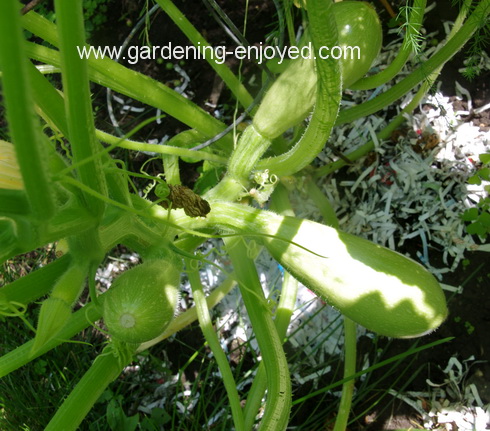
Here is the first of many. We wait patiently for the first Zucchini and then rush it onto the dinner plate and it seems like the next time we look in the garden, we have to start figuring out what to do with all those Zucchini. Each year at planting time I try to remember not to plant too many of them but I’ve grown the seedlings and can’t bring my self to toss the extra into the compost and I usually have more than one variety so we “have to have” some of each?? This lovely light green one is Deema and the seeds come from William Dam Seeds and when I was just reading the description it mentions that they are usually picked at 3 in long, well we failed there already. They are delicious.
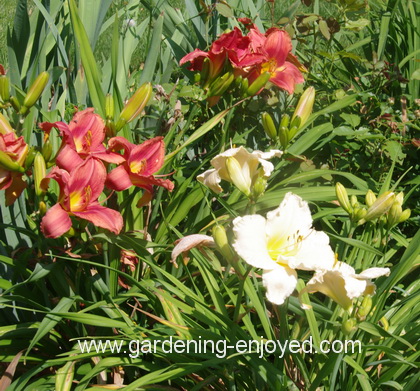
It’s midsummer and that means Daylilies, they’re yellow, pink, orange, red and purple blooms light up the garden for at least the next month. They are tough plants with no real bugs or diseases that make them easy to have in many spots in the garden. We are redoing the berm at the back of the yard and dug and transplanted a few Daylilies even though they were in bloom. A little shot of transplant fertilizer and a couple of good rains and they are carrying on like they had never been moved. They are even still blooming. When buying them from an online catalogue it usually states the bud count. This is important because, as their name implies, they blooms only last one day and the successive buds continue to open on following days, more buds equals longer blooming time.
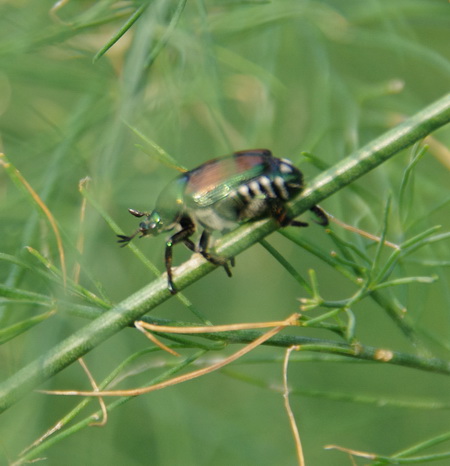
A much less welcome arrival in the garden is the first Japanese Beetles. I’m now killing, I hope, at least a couple of dozen on my morning murderous tour of the garden. They love Roses but right now I’m finding most of them on the Asparagus. They are big and tough and hard to squish so I carry a little spray bottle with Safer’s End All in it. It’s mostly insecticidal soap with 0.1% pyrethrin and it is certified organic. It is a contact killer which means that to be effective you have to actually hit the bug with it as it has no residual effect. I buy their concentrate and mix my own to avoid paying for a new little sprayer each time. I can also adjust my sprayer to give more of a stream than a spray which allows me to hit beetles that are deep in the Asparagus foliage or Rose bush without having to jostle the plant causing the “little” devils to fly away. It also gets used each
morning on the vine crops to kill the striped Cucumber beetle, another dastardly visitor.
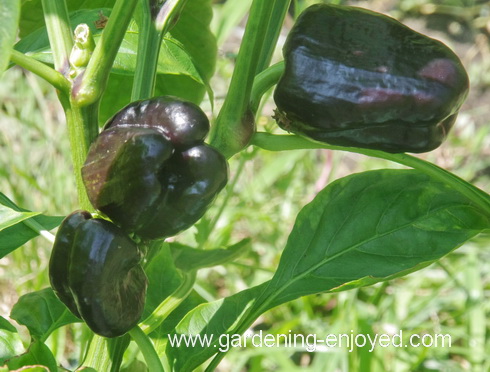
A much more welcome discovery is the arrival of these Dragonfly sweet Peppers. They are relatively early and that deep purple colour is their green stage. If we don’t eat them all at that stage they will eventually ripen to deep orange colour. They are thick walled and prolific. The seeds are available at William Dam’s We eat a lot of them raw because of their delicious flavour but they also find their way into a stir fry on a regular basis. They are a relatively new variety and come with an All America award. The seeds were sown on 17 March and transplanted to the garden in the first week of June when the evening temperatures were consistently warm. Pepper plants will tolerate a cool night but those cool nights will knock the blossoms off and the plant will take its time deciding if it’s warm enough to try
blooming again.

The true Lilies are also lighting up the garden now. I think they are more spectacular than the Daylilies and therefore, at least in my garden, are worth the effort to fight off the Red Lily Beetle and that is really the only pest that bothers them. Their blooms are much shorter lived than the Daylilies but the diversity of sizes and types is much greater. I have some that grow to more than 2 m tall and bear multiple large blooms. One of the biggest is L. Scheherazade at close to 3 m and carrying up to 20 blooms. It is a Orienpet Lily which is a cross between the orientals and the trumpets, mine hasn't bloomed yet. They all grow from bulbs that are usually found in garden centres in the fall which is the best time to plant them.
All parts of both Lilies and Daylilies are extremely toxic to cats and are to be avoided both in the garden and as cut flowers if you have a cat.
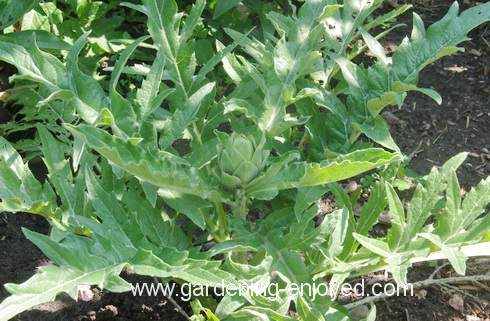 Saving the most exciting for last. This is an Artichoke rapidly developing in my garden. I planted the seed on 02 March and moved it outside on 19 May. Last year we produced one Artichoke very late in the summer but as of now we have 2 developing and they are much earlier. We hope they will produce a few more. It’s just one of those crazy experiments that we like to try and we are using Imperial Star as the variety as it is the most likely to bloom the first year. They are actually a perennial grown in warmer climates and we have no hope that they will survive the winter here. Last year the Assistant Gardener and I had to share that one success but apparently this year we will have at least one each. Even after a few decades of gardening there is always something else to try to keep the interest level at a its peak.
Saving the most exciting for last. This is an Artichoke rapidly developing in my garden. I planted the seed on 02 March and moved it outside on 19 May. Last year we produced one Artichoke very late in the summer but as of now we have 2 developing and they are much earlier. We hope they will produce a few more. It’s just one of those crazy experiments that we like to try and we are using Imperial Star as the variety as it is the most likely to bloom the first year. They are actually a perennial grown in warmer climates and we have no hope that they will survive the winter here. Last year the Assistant Gardener and I had to share that one success but apparently this year we will have at least one each. Even after a few decades of gardening there is always something else to try to keep the interest level at a its peak.
We are regularly traveling to speaking engagements and are always happy to add more to the schedule. If your club or group would like
to have me present one of my informative and entertaining talks just fill out the speaker request form and we can find a suitable date and topic.
If you have any gardening questions just “reply” to this newsletter and I will attempt to answer them.
Carol Asks? Do Clematis grow best in full sun?
Ken Answers!
I have some in full sun and some in part shade. The ones in the sun seem to do better. The old wisdom was to have the vines in the sun and the roots in the shade but that's frequently a bit of a challenge and doesn't really seem to matter that much.
Nazmul Asks?
I have a pear tree and the leaves and fruit develop black spots. I have tried spraying with soapy water and also with diluted vinegar solution. Nothing has worked. Any solutions?
Ken Answers! It would
appear to be a fungus disease, Pear black spot and there is not much you can do about it now. It just bothers the skin and peeling the Pears will remove for eating. Check this website for further information. http://www.omafra.gov.on.ca/IPM/english/tender/diseases-and-disorders/fabraea.html
|

 Saving the most exciting for last. This is an Artichoke rapidly developing in my garden. I planted the seed on 02 March and moved it outside on 19 May. Last year we produced one Artichoke very late in the summer but as of now we have 2 developing and they are much earlier. We hope they will produce a few more. It’s just one of those crazy experiments that we like to try and we are using Imperial Star as the variety as it is the most likely to bloom the first year. They are actually a perennial grown in warmer climates and we have no hope that they will survive the winter here. Last year the Assistant Gardener and I had to share that one success but apparently this year we will have at least one each. Even after a few decades of gardening there is always something else to try to keep the interest level at a its peak.
Saving the most exciting for last. This is an Artichoke rapidly developing in my garden. I planted the seed on 02 March and moved it outside on 19 May. Last year we produced one Artichoke very late in the summer but as of now we have 2 developing and they are much earlier. We hope they will produce a few more. It’s just one of those crazy experiments that we like to try and we are using Imperial Star as the variety as it is the most likely to bloom the first year. They are actually a perennial grown in warmer climates and we have no hope that they will survive the winter here. Last year the Assistant Gardener and I had to share that one success but apparently this year we will have at least one each. Even after a few decades of gardening there is always something else to try to keep the interest level at a its peak. 




